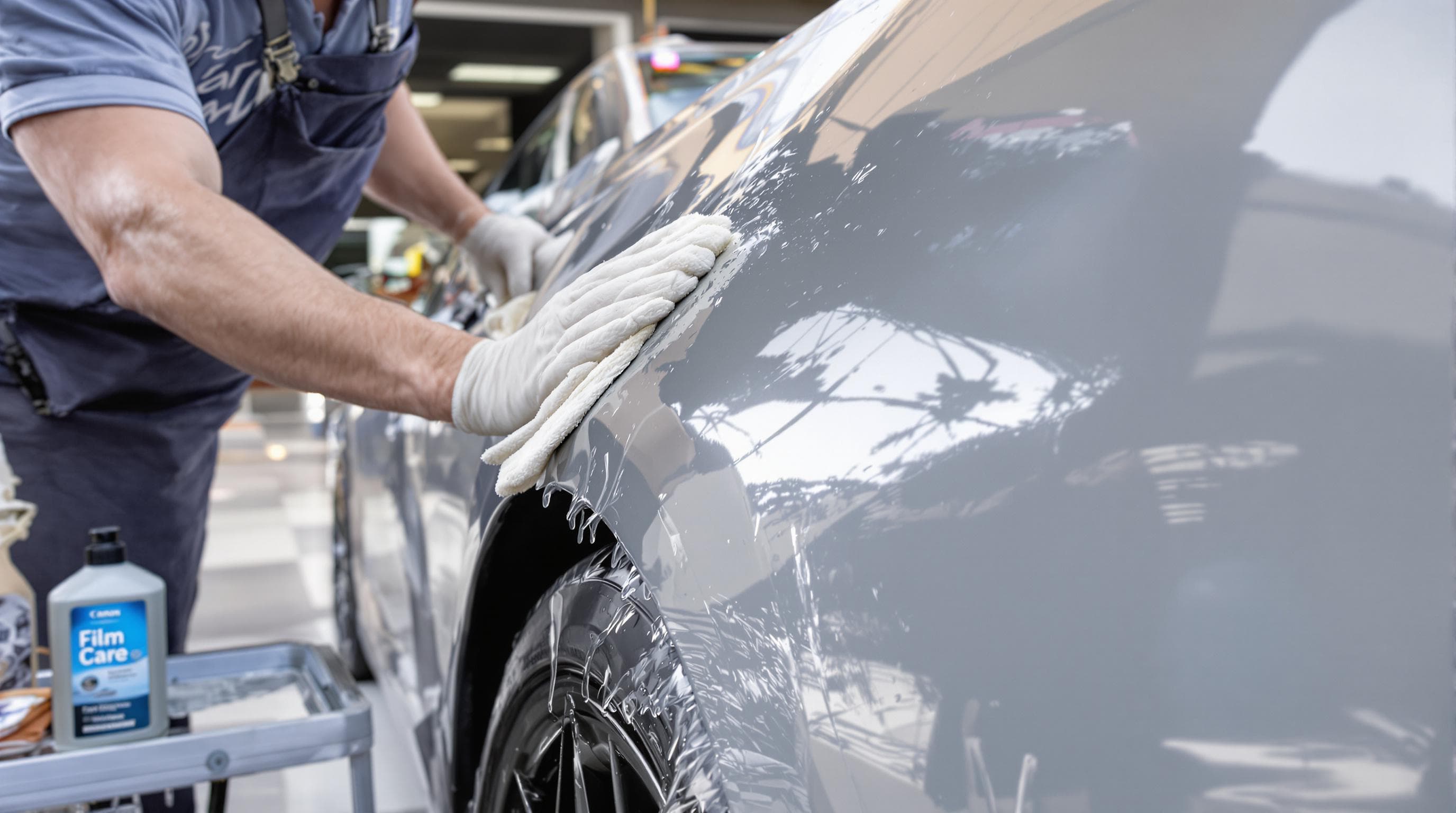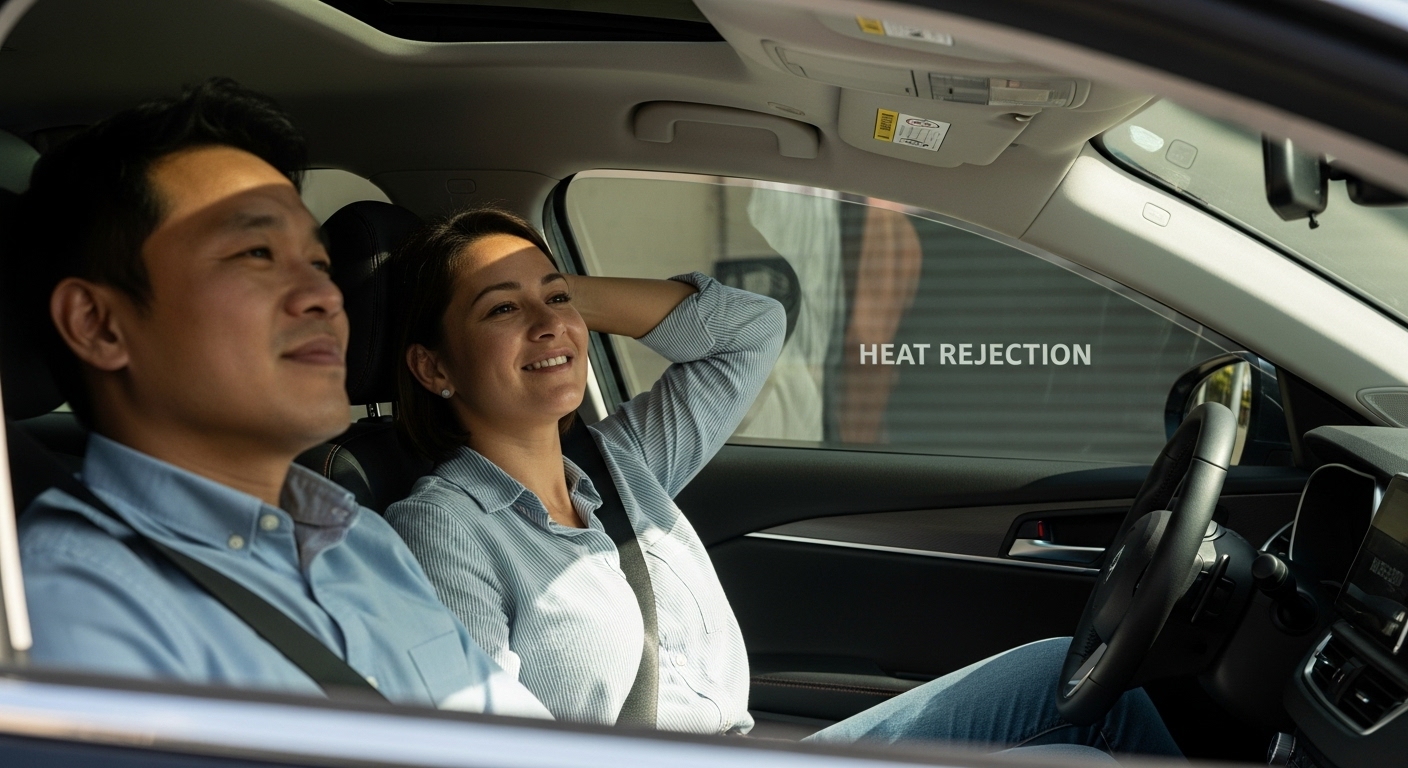

Paint protection film has become essential for keeping vehicles looking flawless and fresh for years. You might assume it is as simple as sticking on some clear plastic and forgetting about it. Yet, studies show that top tier films with advanced polymers can last well over 10 years if installed and maintained correctly, while cheaper versions may start yellowing or cracking after just a few seasons. The real difference lies not in the film itself, but in how material choice, installation skill, and daily care quietly determine whether that protective layer stands the test of time.
Table of Contents
- Key Factors Impacting Paint Protection Film Lifespan
- How To Maximise PPF Durability In Professional Settings
- Signs Your Paint Protection Film Needs Replacing
- Choosing Quality Films For Longer Lifespan
Quick Summary
| Takeaway | Explanation |
|---|---|
| Material Quality Matters | Higher-quality PPFs, featuring advanced polymer technologies, provide superior durability and protection against environmental challenges, making material choice critical for longevity. |
| Environmental Exposure is Key | Factors like UV radiation, temperature extremes, and chemical exposure significantly degrade PPF. Educating clients on strategic parking and regular maintenance can mitigate these issues. |
| Installation Precision is Crucial | Proper installation techniques—such as meticulous surface preparation and careful edge sealing—are essential for maintaining PPF performance and longevity. |
| Regular Maintenance Extends Lifespan | Following specific washing protocols, using pH-neutral cleaning products, and conducting regular inspections can significantly enhance the durability of PPF. |
| Signs of Degradation | Professionals should be vigilant for visual signs like yellowing and loss of gloss, as well as structural issues like edge lifting, to determine when PPF needs replacing. |
Key Factors Impacting Paint Protection Film Lifespan
Professional installers understand that paint protection film (PPF) performance goes far beyond simple application. Multiple critical factors directly influence the longevity and effectiveness of protective films, determining whether a vehicle’s surface remains pristine or succumbs to environmental degradation.

Material Quality and Composition
The fundamental determinant of paint protection film lifespan begins with its inherent material properties. According to ProTex Installers, higher-quality films demonstrate superior resistance against environmental challenges. Professional-grade PPF typically incorporates advanced polymer technologies that provide enhanced durability and protection.
Manufacturers invest significant research into developing films with robust chemical compositions that can withstand multiple stress factors. These sophisticated materials integrate self-healing properties, UV resistance, and molecular structures designed to resist yellowing and cracking. Professionals seeking optimal performance must prioritize films engineered with cutting-edge polymeric technologies.
Environmental Exposure and Degradation Mechanisms
Environmental conditions play a pivotal role in determining PPF lifespan. A comprehensive study on polymeric material degradation reveals that photodegradation driven by ultraviolet radiation represents a primary mechanism of film deterioration. Vehicles consistently exposed to intense sunlight experience accelerated material breakdown, compromising protective capabilities.
Multiple environmental factors contribute to PPF degradation:
- Temperature Extremes: Consistent exposure to high temperatures can cause material expansion and contraction
- UV Radiation: Direct sunlight breaks down molecular bonds in protective films
- Chemical Exposure: Road salts, industrial pollutants, and industrial contaminants accelerate material degradation
Professional installers must educate clients about the importance of strategic parking and routine maintenance to mitigate these environmental challenges. Our guide on paint protection film benefits provides additional insights into protecting automotive surfaces.
Installation Quality and Maintenance Practices
Beyond material composition, installation precision dramatically influences PPF performance. Improper application can introduce microscopic vulnerabilities that compromise long-term protection. Professional installers must maintain meticulous standards, ensuring:
- Precise surface preparation
- Dust-free application environments
- Careful edge sealing
- Minimal handling during installation
Routine maintenance further extends film lifespan. Regular cleaning using recommended techniques prevents contaminant buildup and minimizes potential damage. Professionals should develop comprehensive care protocols that protect their clients investment and maintain optimal protective performance.
Understanding these intricate factors allows automotive professionals to select, apply, and maintain paint protection films that deliver exceptional long-term value and protection.
To help professionals quickly reference the major factors influencing PPF lifespan, the following table organises the key elements outlined in this section:
| Factor | Description | Example Impact |
|---|---|---|
| Material Quality & Composition | Advanced polymers with self-healing, UV resistance, & anti-yellowing properties | +10 years lifespan possible |
| Environmental Exposure | UV rays, temperature swings, chemicals degrade film over time | Early yellowing, cracking |
| Installation Quality | Careful prep, edge sealing, dust-free technique critical for effectiveness | Prevents lifting, premature failure |
| Maintenance Practices | Regular gentle cleaning and inspections protect film against contaminants | Maximises durability |
How to Maximise PPF Durability in Professional Settings

Professional automotive protection specialists understand that maximising paint protection film (PPF) durability requires a strategic approach that goes beyond simple application. Implementing comprehensive maintenance and protection protocols can significantly extend the lifespan and performance of protective films.
Precise Washing and Cleaning Protocols
Maintaining PPF demands a meticulous approach to cleaning. According to The Project 3, professionals must observe critical waiting periods and use specialized cleaning techniques. Specifically, installers should advise clients to wait 4872 hours after installation before initial washing, ensuring proper film settlement and adhesion.
Key washing recommendations include:
- pH-Neutral Products: Use specifically formulated car shampoos that do not compromise film integrity
- Soft Microfibre Materials: Employ gentle cleaning tools to prevent surface abrasion
- Avoid High-Pressure Washing: Minimize direct pressure near film edges to prevent potential lifting or damage
Our guide on paint protection film techniques provides additional insights into maintaining optimal film performance.
Environmental Protection Strategies
Environmental exposure represents a significant challenge for PPF durability. PPF Authority emphasizes the importance of strategic protection against UV radiation and environmental contaminants. Professionals should recommend comprehensive protection strategies that extend beyond traditional cleaning practices.
Critical environmental protection techniques include:
- Strategic Parking: Prioritize shaded or covered parking locations
- Prompt Contaminant Removal: Address bird droppings, tree sap, and industrial fallout immediately
- Regular Inspection: Conduct routine assessments for early detection of potential film degradation
Professional Maintenance and Long-Term Care
Professional installers must develop comprehensive maintenance protocols that address both immediate and long-term film preservation. The Works Auto Center recommends establishing clear client education programs that emphasize proper care techniques.
Essential long-term maintenance practices include:
- Periodic Professional Evaluation: Schedule regular professional inspections
- Detailed Care Instructions: Provide clients with specific maintenance guidelines
- Recommended Product Usage: Suggest approved cleaning and protection products
By implementing these sophisticated durability enhancement strategies, automotive protection professionals can ensure maximum performance and longevity of paint protection films. The key lies in a proactive, comprehensive approach that combines expert installation, precise maintenance, and ongoing professional support.
To quickly review the most important maintenance and protection practices for maximising film lifespan, refer to this summary table:
| Practice | Description | Benefit |
|---|---|---|
| Wait before First Wash | 48–72 hours after install for adhesion | Prevents early film damage |
| pH-Neutral Cleaning | Use gentle, specialised shampoos | Maintains film integrity |
| Soft Microfibre Tools | Avoids scratching or surface abrasion | Preserves surface gloss |
| Avoid High-Pressure Washers | No strong jets near edges | Stops peeling/lifting |
| Shaded/Covered Parking | Protects from UV and temperature extremes | Slows degradation |
| Prompt Contaminant Removal | Clean off bird droppings, sap, fallout immediately | Prevents permanent marking |
| Regular Professional Inspections | Routine checks and care advice | Detects early problems |
Signs Your Paint Protection Film Needs Replacing
Professional automotive protection specialists must develop a keen eye for identifying when paint protection film (PPF) has reached its functional limit. Recognizing the critical signs of film degradation ensures timely replacement and maintains optimal vehicle surface protection.
Visual Degradation and Discoloration
Discoloration represents a primary indicator of PPF deterioration. According to Atomic Auto Spa, high-quality PPF typically maintains its integrity for 5 to 10 years before showing significant signs of wear. Professionals should carefully assess visual changes that compromise the film’s aesthetic and protective qualities.
Key visual degradation signs include:
- Yellowing: Gradual color transformation indicating UV exposure and material breakdown
- Loss of Gloss: Reduction in film’s original shine and reflective properties
- Clouding: Visible haziness that diminishes film transparency
Our guide on paint protection film benefits offers additional insights into maintaining film quality.
Physical Damage and Structural Integrity
Physical indicators of PPF failure extend beyond surface appearance. Paint Protection Film Experts highlight several critical structural signs that warrant immediate replacement:
- Edge Lifting: Visible separation of film edges from vehicle surface
- Persistent Scratches: Loss of self-healing properties where damage remains visible
- Cracking or Brittleness: Structural breakdown indicating material fatigue
- Bubble Formation: Indication of adhesive failure or moisture intrusion
Professionals must conduct thorough visual and tactile inspections to identify these potential compromise points. Minor imperfections can quickly escalate into comprehensive film failure if left unaddressed.
Environmental and Performance Degradation
Beyond visual and physical signs, performance degradation signals the need for PPF replacement. Veishop emphasizes the importance of assessing the film’s ability to protect against environmental challenges.
Critical performance indicators include:
- Reduced UV Protection: Diminished ability to block harmful solar radiation
- Compromised Stain Resistance: Increased susceptibility to environmental contaminants
- Decreased Hydrophobic Properties: Reduced water-repelling capabilities
Professional installers must educate clients about these nuanced indicators. Proactive replacement prevents potential long-term damage to the vehicle’s underlying paint surface. Regular professional assessments allow for timely intervention, ensuring continuous protection and maintaining the vehicle’s aesthetic and structural integrity.
Understanding these comprehensive replacement indicators empowers automotive protection professionals to deliver superior service and maintain the highest standards of vehicle surface protection.
To help professionals quickly spot when PPF should be replaced, here’s a table summarising the main signs and their implications:
| Indicator | Example Signs | Likely Cause |
|---|---|---|
| Yellowing | Film turns yellow | UV exposure, material breakdown |
| Loss of Gloss | Dull or faded appearance | Ageing, contaminants |
| Clouding/Haziness | Film looks foggy | Water/chemical intrusion |
| Edge Lifting | Edges peel away from surface | Poor adhesion, wear |
| Cracking/Brittleness | Fine cracks, stiffening, fragmentation | Material fatigue, exposure |
| Bubble Formation | Visible bubbles under the film | Adhesive/moisture failure |
| Persistent Scratches | Damage not self-healing | Exceeded film capability |
Choosing Quality Films for Longer Lifespan
Professional automotive protection specialists understand that selecting superior paint protection film (PPF) is a critical decision that directly impacts vehicle surface preservation and long-term client satisfaction. The quality of film selection determines not just immediate protection but the sustained performance over years of environmental exposure.
Scientific Evaluation of Film Performance
Advanced material science plays a pivotal role in understanding PPF durability. Research from Accelerated Test Methodology highlights the importance of comprehensive evaluation techniques that predict polymeric material service life. Professionals must consider multiple scientific parameters when assessing film quality.
Key scientific performance indicators include:
- UV Resistance Spectrum: Ability to withstand different wavelengths of ultraviolet radiation
- Molecular Stability: Chemical composition resilience under temperature variations
- Photodegradation Resistance: Capacity to maintain structural integrity during prolonged environmental exposure
Our comprehensive guide on paint protection film techniques provides deeper insights into technical film selection criteria.
Material Composition and Technology
Professional-grade PPF distinguishes itself through advanced material engineering. Top-tier films incorporate sophisticated polymer technologies that offer enhanced protective capabilities. Installers should prioritize films demonstrating:
- Self-Healing Properties: Ability to recover from minor surface scratches
- Elastomeric Characteristics: Flexibility that allows conforming to complex vehicle contours
- Advanced Adhesive Systems: Robust bonding mechanisms ensuring long-term surface adherence
The selection process requires meticulous evaluation beyond surface-level appearances. Professionals must analyze technical specifications, manufacturer warranties, and independent laboratory testing results.
Performance Validation and Manufacturer Credentials
Credible film selection demands comprehensive performance validation. Automotive protection specialists should scrutinize manufacturer credentials through:
- Independent Testing Documentation: Verifiable performance data from recognized laboratories
- Warranty Coverage: Comprehensive protection periods indicating manufacturer confidence
- Professional Endorsements: Recommendations from industry-leading automotive protection associations
Beyond technical specifications, consider manufacturer reputation, research investment, and commitment to continuous product innovation. The most reliable PPF manufacturers demonstrate consistent technological advancement and transparent performance documentation.
Ultimately, choosing quality films requires a holistic approach combining scientific understanding, technical evaluation, and professional expertise. Automotive protection professionals who master this selection process deliver superior value to their clients, ensuring long-lasting vehicle surface protection.
Frequently Asked Questions
What is the typical lifespan of paint protection film (PPF)?
The lifespan of high-quality paint protection film can exceed 10 years if correctly installed and maintained, while cheaper options may degrade in just a few seasons.
What factors impact the longevity of PPF?
Factors such as material quality, environmental exposure, installation practices, and regular maintenance all play significant roles in determining the lifespan of paint protection film.
How can I extend the lifespan of my paint protection film?
You can extend PPF lifespan by following proper washing protocols, using pH-neutral cleaning products, avoiding high-pressure washing, and conducting regular inspections to address any potential issues quickly.
What are the signs that paint protection film needs replacing?
Key signs of PPF needing replacement include yellowing, loss of gloss, edge lifting, visible cracks, and reduced performance in UV protection and stain resistance.
Transform PPF Lifespan Insights into Unmatched Installation Results
Achieving maximum paint protection film lifespan hinges on both the quality of your material and the precision of your application. As explored in this guide, issues like environmental exposure, imperfect installation, and wasted materials can cut years off a film’s effectiveness. If you are determined to give your clients consistently durable results, it is time to rethink your PPF workflow.
Discover featured solutions to boost your efficiency

Let the AEONCUT software empower you with precise pre-cut patterns that reduce errors and material waste. With advanced design tools and a constantly updated pattern library, you can consistently achieve professional-quality finishes and satisfied clients. Explore how you can dramatically elevate both speed and accuracy by visiting AEONCUT PPF Pre-cut Cutting software today. Take charge of your reputation for long-lasting, flawless PPF installations — get started now.
Recommended
- Top Paint Protection Film Benefits for Auto Professionals 2025 – AEONCUT PPF Pre-cut Cutting software
- PPF for Motorcycles: 2025 Guide for Installers & Detailers – AEONCUT PPF Pre-cut Cutting software
- Types of Window Tint: Guide for Installers and Dealers 2025 – AEONCUT PPF Pre-cut Cutting software
- PPF Cutting Software: Essential Guide for Installers 2025 – AEONCUT PPF Pre-cut Cutting software



